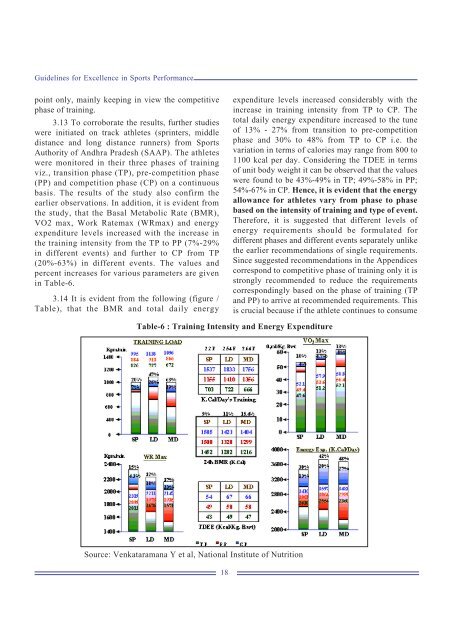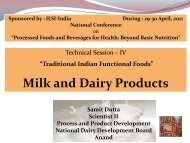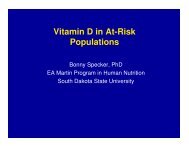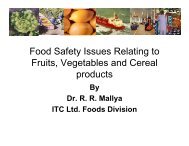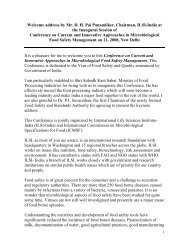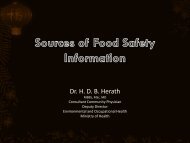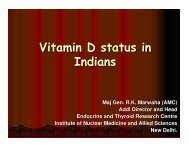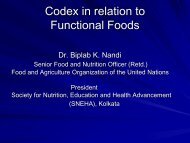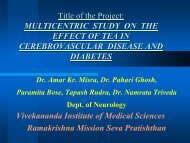Nutrition and Hydration Guidelines for Excellence in Sports - ILSI India
Nutrition and Hydration Guidelines for Excellence in Sports - ILSI India
Nutrition and Hydration Guidelines for Excellence in Sports - ILSI India
Create successful ePaper yourself
Turn your PDF publications into a flip-book with our unique Google optimized e-Paper software.
<strong>Guidel<strong>in</strong>es</strong> <strong>for</strong> <strong>Excellence</strong> <strong>in</strong> <strong>Sports</strong> Per<strong>for</strong>mance<br />
po<strong>in</strong>t only, ma<strong>in</strong>ly keep<strong>in</strong>g <strong>in</strong> view the competitive<br />
phase of tra<strong>in</strong><strong>in</strong>g.<br />
3.13 To corroborate the results, further studies<br />
were <strong>in</strong>itiated on track athletes (spr<strong>in</strong>ters, middle<br />
distance <strong>and</strong> long distance runners) from <strong>Sports</strong><br />
Authority of Andhra Pradesh (SAAP). The athletes<br />
were monitored <strong>in</strong> their three phases of tra<strong>in</strong><strong>in</strong>g<br />
viz., transition phase (TP), pre-competition phase<br />
(PP) <strong>and</strong> competition phase (CP) on a cont<strong>in</strong>uous<br />
basis. The results of the study also confirm the<br />
earlier observations. In addition, it is evident from<br />
the study, that the Basal Metabolic Rate (BMR),<br />
VO2 max, Work Ratemax (WRmax) <strong>and</strong> energy<br />
expenditure levels <strong>in</strong>creased with the <strong>in</strong>crease <strong>in</strong><br />
the tra<strong>in</strong><strong>in</strong>g <strong>in</strong>tensity from the TP to PP (7%-29%<br />
<strong>in</strong> different events) <strong>and</strong> further to CP from TP<br />
(20%-63%) <strong>in</strong> different events. The values <strong>and</strong><br />
percent <strong>in</strong>creases <strong>for</strong> various parameters are given<br />
<strong>in</strong> Table-6.<br />
3.14 It is evident from the follow<strong>in</strong>g (figure /<br />
Table), that the BMR <strong>and</strong> total daily energy<br />
expenditure levels <strong>in</strong>creased considerably with the<br />
<strong>in</strong>crease <strong>in</strong> tra<strong>in</strong><strong>in</strong>g <strong>in</strong>tensity from TP to CP. The<br />
total daily energy expenditure <strong>in</strong>creased to the tune<br />
of 13% - 27% from transition to pre-competition<br />
phase <strong>and</strong> 30% to 48% from TP to CP i.e. the<br />
variation <strong>in</strong> terms of calories may range from 800 to<br />
1100 kcal per day. Consider<strong>in</strong>g the TDEE <strong>in</strong> terms<br />
of unit body weight it can be observed that the values<br />
were found to be 43%-49% <strong>in</strong> TP; 49%-58% <strong>in</strong> PP;<br />
54%-67% <strong>in</strong> CP. Hence, it is evident that the energy<br />
allowance <strong>for</strong> athletes vary from phase to phase<br />
based on the <strong>in</strong>tensity of tra<strong>in</strong><strong>in</strong>g <strong>and</strong> type of event.<br />
There<strong>for</strong>e, it is suggested that different levels of<br />
energy requirements should be <strong>for</strong>mulated <strong>for</strong><br />
different phases <strong>and</strong> different events separately unlike<br />
the earlier recommendations of s<strong>in</strong>gle requirements.<br />
S<strong>in</strong>ce suggested recommendations <strong>in</strong> the Appendices<br />
correspond to competitive phase of tra<strong>in</strong><strong>in</strong>g only it is<br />
strongly recommended to reduce the requirements<br />
correspond<strong>in</strong>gly based on the phase of tra<strong>in</strong><strong>in</strong>g (TP<br />
<strong>and</strong> PP) to arrive at recommended requirements. This<br />
is crucial because if the athlete cont<strong>in</strong>ues to consume<br />
Table-6 : Tra<strong>in</strong><strong>in</strong>g Intensity <strong>and</strong> Energy Expenditure<br />
Source: Venkataramana Y et al, National Institute of <strong>Nutrition</strong><br />
18 24


